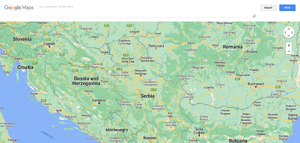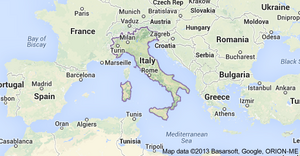Serbia
| Author:Laxman Burdak, IFS (R) |


Serbia (Serbian: Република Србија) is a country located at the crossroads of Central and Southeast Europe, covering the southern part of the Pannonian Plain and the central Balkans. The capital of Serbia, Belgrade, is among Europe's oldest cities and one of the largest in Southeast Europe.
Variants
Location
A landlocked country in relative proximity to the Mediterranean, Serbia borders Hungary to the north; Romania and Bulgaria to the east; Macedonia to the south; and Croatia, Bosnia, and Montenegro to the west; it also borders Albania through the disputed territory of Kosovo.
Origin of name
The name "Serbia" was first mentioned as Greek: Σέρβια, meaning "land of the Serbs". There are many theories regarding the origin of the name of the Serbs. The most likely is that it is derived from the Old Slavic root *serb-, meaning "same".[1] Another proposed etymology is that of the Indo-European root *ser- "to watch over, protect", akin to Latin servare "to keep, guard, protect, preserve, observe".[2]
History
In 2005, several possibly Triballi graves were found at the Hisar Hill in Leskovac, southeastern Serbia.[3]
In June 2008, a Triballi grave was found together with ceramics (urns) in Požarevac, central-eastern Serbia.[4]
Triballi tomb unearthed at Ljuljaci, west of Kragujevac, central Serbia.[5]
Jat History
DNA study on Y-STR Haplogroup Diversity in the Jat Population
David G. Mahal and Ianis G. Matsoukas[6] conducted a scientific study on Y-STR Haplogroup Diversity in the Jat Population of which brief Conclusion is as under:
The Jats represent a large ethnic community that has inhabited the northwest region of India and Pakistan for several thousand years. It is estimated the community has a population of over 123 million people. Many historians and academics have asserted that the Jats are descendants of Aryans, Scythians, or other ancient people that arrived and lived in northern India at one time. Essentially, the specific origin of these people has remained a matter of contention for a long time. This study demonstrated that the origins of Jats can be clarified by identifying their Y-chromosome haplogroups and tracing their genetic markers on the Y-DNA haplogroup tree. A sample of 302 Y-chromosome haplotypes of Jats in India and Pakistan was analyzed. The results showed that the sample population had several different lines of ancestry and emerged from at least nine different geographical regions of the world. It also became evident that the Jats did not have a unique set of genes, but shared an underlying genetic unity with several other ethnic communities in the Indian subcontinent. A startling new assessment of the genetic ancient origins of these people was revealed with DNA science.
The human Y-chromosome provides a powerful molecular tool for analyzing Y-STR haplotypes and determining their haplogroups which lead to the ancient geographic origins of individuals. For this study, the Jats and 38 other ethnic groups in the Indian subcontinent were analyzed, and their haplogroups were compared. Using genetic markers and available descriptions of haplogroups from the Y-DNA phylogenetic tree, the geographic origins and migratory paths of their ancestors were traced.
The study demonstrated that based on their genetic makeup, the Jats belonged to at least nine specific haplogroups, with nine different lines of ancestry and geographic origins. About 90% of the Jats in our sample belonged to only four different lines of ancestry and geographic origins:
1. Haplogroup L (36.8%)- The origins of this haplogroup can be traced to the rugged and mountainous Pamir Knot region in Tajikistan.
2. Haplogroup R (28.5%): From somewhere in Central Asia, some descendants of the man carrying the M207 mutation on the Y chromosome headed south to arrive in India about 10,000 years ago (Wells, 2007). This is one of the largest haplogroups in India and Pakistan. Of its key subclades, R2 is observed especially in India and central Asia.
3. Haplogroup Q (15.6%): With its origins in central Asia, descendants of this group are linked to the Huns, Mongols, and Turkic people. In Europe it is found in southern Sweden, among Ashkenazi Jews, and in central and Eastern Europe such as, the Rhône-Alpes region of France, southern Sicily, southern Croatia, northern Serbia, parts of Poland and Ukraine.
4. Haplogroup J (9.6%): The ancestor of this haplogroup was born in the Middle East area known as the Fertile Crescent, comprising Israel, the West Bank, Jordon, Lebanon, Syria, and Iraq. Middle Eastern traders brought this genetic marker to the Indian subcontinent (Kerchner, 2013).
5.-9. Haplogroups E, G, H, I, T (9.5%): The ancestors of the remaining five haplogroups E, G, H, I, and T can be traced to different parts of Africa, Middle East, South Central Asia, and Europe (ISOGG, 2016).
Therefore, attributing the origins of this entire ethnic group to loosely defined ancient populations such as, Indo-Aryans or Indo-Scythians represents very broad generalities and cannot be supported. The study also revealed that even with their different languages, religions, nationalities, customs, cuisines, and physical differences, the Jats shared their haplogroups with several other ethnic groups of the Indian subcontinent, and had the same common ancestors and geographic origins in the distant past. Based on recent developments in DNA science, this study provided new insights into the ancient geographic origins of this major ethnic group in the Indian subcontinent. A larger dataset, particularly with more representation of Muslim Jats, is likely to reveal some additional haplogroups and geographical origins for this ethnic group.
External links
References
- ↑ "Projekat Rastko – Luzica / Project Rastko – Lusatia"
- ↑ J.P. Mallory and D.Q. Adams, "Protect", The Encyclopedia of Indo-European Culture (London: Fitzroy and Dearborn, 1997).
- ↑ "Praistorijska kopča". b92.net.
- ↑ "www.jasatomic.org.yu - Katastrofalna poplava u mestu Jaša Tomić opština Sečanj (BANAT)".
- ↑ Tribalski grobovi u LjuljacimaLes sépultures triballes de Ljuljaci". cat.inist.fr.
- ↑ Y-STR Haplogroup Diversity in the Jat Population Reveals Several Different Ancient Origins
Back to Europe

